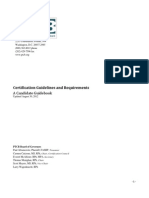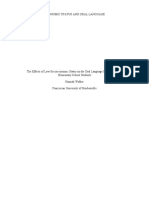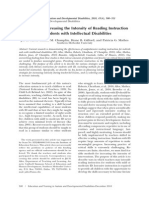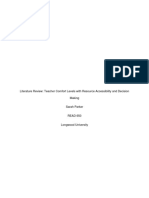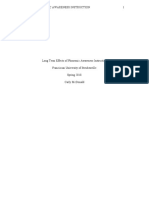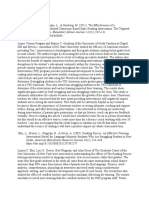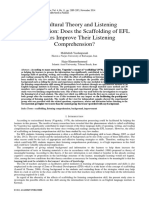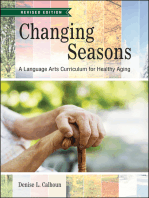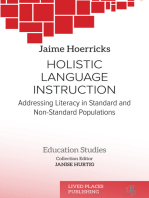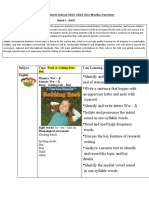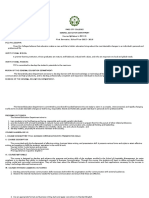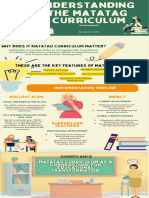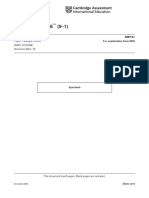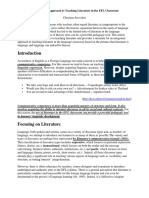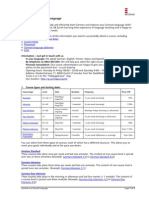0 ratings0% found this document useful (0 votes)
33 viewsWeinstockannotatedbib
Weinstockannotatedbib
Uploaded by
api-262714178The document discusses three annotated bibliographies about equity in the classroom and social curriculum for deaf students. The first article discusses a study of teachers' perspectives on standards-based instruction in deaf-only, hearing-only, and mixed classrooms. The second article looks at ensuring equity in assessment and testing accommodations for deaf and hard of hearing students. The third article focuses on socialization factors between deaf students of different ages, cochlear implant use, and home language environments.
Copyright:
© All Rights Reserved
Available Formats
Download as DOCX, PDF, TXT or read online from Scribd
Weinstockannotatedbib
Weinstockannotatedbib
Uploaded by
api-2627141780 ratings0% found this document useful (0 votes)
33 views9 pagesThe document discusses three annotated bibliographies about equity in the classroom and social curriculum for deaf students. The first article discusses a study of teachers' perspectives on standards-based instruction in deaf-only, hearing-only, and mixed classrooms. The second article looks at ensuring equity in assessment and testing accommodations for deaf and hard of hearing students. The third article focuses on socialization factors between deaf students of different ages, cochlear implant use, and home language environments.
Original Title
weinstockannotatedbib
Copyright
© © All Rights Reserved
Available Formats
DOCX, PDF, TXT or read online from Scribd
Share this document
Did you find this document useful?
Is this content inappropriate?
The document discusses three annotated bibliographies about equity in the classroom and social curriculum for deaf students. The first article discusses a study of teachers' perspectives on standards-based instruction in deaf-only, hearing-only, and mixed classrooms. The second article looks at ensuring equity in assessment and testing accommodations for deaf and hard of hearing students. The third article focuses on socialization factors between deaf students of different ages, cochlear implant use, and home language environments.
Copyright:
© All Rights Reserved
Available Formats
Download as DOCX, PDF, TXT or read online from Scribd
Download as docx, pdf, or txt
0 ratings0% found this document useful (0 votes)
33 views9 pagesWeinstockannotatedbib
Weinstockannotatedbib
Uploaded by
api-262714178The document discusses three annotated bibliographies about equity in the classroom and social curriculum for deaf students. The first article discusses a study of teachers' perspectives on standards-based instruction in deaf-only, hearing-only, and mixed classrooms. The second article looks at ensuring equity in assessment and testing accommodations for deaf and hard of hearing students. The third article focuses on socialization factors between deaf students of different ages, cochlear implant use, and home language environments.
Copyright:
© All Rights Reserved
Available Formats
Download as DOCX, PDF, TXT or read online from Scribd
Download as docx, pdf, or txt
You are on page 1of 9
Joshua Weinstock September 14, 2014
UCSD EDS 201 Sewall/Millstone
Annotated Bibliography
Equity In the Classroom (2)
Cawthon, S. (Winter 2004/2005). Early Elementary Curricular Alignment and
Teacher Perspectives on Standards-Based Reform. American Annals of the
Deaf, 149(5), 428-435.
This article discusses teachers in three separate settings of reading
instruction. 18 hearing only, 10 hearing and deaf mixed and 8 deaf only elementary
classrooms at Wisconsin were study participants using standards-based instruction.
The teachers had to use standards as a guideline for their instructional approach in
each classroom and found that each setting has different challenges for point of
emphasis in teaching. From the study, three hypotheses were developed and the
findings resulted into topics of Reading Curriculum that is found in the appendix of
the article. The appendix features various Reading comprehension, materials, word
recognition and other mechanics i.e. vocabulary, authors purpose, poetry,
biographies, phonemic awareness, compound words, rhymes and analogies. This
article would benefit educational institutions that have mixed classrooms and help
determine if they should segregate in deaf-only/hearing-only classrooms instead of
continuing to mainstream both types together.
The studies were conducted with 135 deaf students 74 in deaf only and 61
in mixed classroom and 608 hearing students 178 in mixed classroom and 430 in
hearing classroom only. The study measured the teachers views on standards based
on their self-report from experience of classroom instruction. The study findings
showed that teachers with homogenous classrooms (deaf only or hearing only) have
a better experience with standards instruction than a more diverse classroom
population. Teachers in deaf-only classrooms had the opportunity to provide
educational equity in a pattern of common based-instruction (language, shared
experience, communication accessibility). Each deaf-only and hearing-only teacher
separately shared their concern for their respective classrooms. However, it was
found that teachers in mixed classrooms responded with a wider range of concerns
than teachers that was also found in both deaf-only and hearing-only classrooms.
This study shows that equitable opportunity to learn standards content does not
necessarily mean each classroom would look the same; and instruction will vary
based on the teachers ability to recognize students individual needs and challenges
especially deaf students.
I agree with the idea of having a deaf-only classroom instead of being
mainstreamed with hearing students. This would mean a teacher would have to deal
with two different communication methods in one classroom, which puts too much
pressure on their preparation. In education, direct communication is essential, and
it becomes an issue if the teacher is more worried about ensuring the hearing
students and deaf students (through interpreter, or simultaneous communication i.e.
signing and speaking at the same time) receiving the appropriate content than
delivering the appropriate content. A deaf teacher and classmates would understand
the dynamics of a deaf-only classroom better than a hearing teacher and hearing
classmates would in a mixed classroom.
I have only experienced a deaf-only classroom, so I understand the benefits
of learning in this environment. At UCSD, it is my first experience being
mainstreamed with an interpreter in the classroom. There were several challenges I
faced videos without captioning, flow of conversation and not knowing when
table/partner discussion is ending soon in a mixed classroom. I know that in the
future I will want to teach in a deaf-only classroom, but it is beneficial for me to be
familiar with a mixed classroom setting to ensure equity by appropriate instruction
is provided for everyone. In any classroom, I would want each student to be placed
in the best position to succeed academically.
Sligar, S., Cawthon, S., Morere, D., & Moxley, A. (2003). Equity in Assessment
for Individuals who are Deaf or Hard of Hearing. Journal of the American
Deafness & Rehabilitation Association, 47(1), 110-127.
This study looks at equity in assessment and test taking for deaf and hard of
hearing (DHH) students. The four writers from separate institutes discusses how
essential it is for the DHH individuals to have equity in the form of accommodations
and modifications in the assessment process/test taking. In 2007, PEPNet
(pepnet.org) organized a Test Equity Summit to address this issue, and three topics
comes up in the article; essential issues in assessment with individuals who are DHH,
assessments to identify additional disabilities, and assessment tools used in
vocational evaluation.
This study assessed that the test developers should consider having an
alternative test administrator for the oral portion of a test if the test taker does not
use oral language instead of bypassing the section. This means the test
administrators needs to be trained in test administration proficiency, based on the
biological, psychological and social aspects of DHH. They should also be fluent based
on the students communication skills to ensure optimal communication directly or
through a qualified interpreter who would need to go through training before the
test with the test administrator. Typically, there are many other factors of deaf
students with additional learning disabilities, which means it is recommended for
the test taker to have rapport with the adult in the room. The study concludes with a
Table that has the issue on one column with a recommendation on the pairing
column in summarization of the article.
I recognize the importance of having an appropriate communication
approach to assess DHH students. It is important for educators of DHH students to
understand in order for a DHH student to realize their maximum aptitude in testing;
they must be accommodated appropriately in their preference of language usage. If
the DHH student does not receive the information because of the test
administrators inability to accommodate them, the test scores would reflect their
lack of understanding. This would have a negative effect that leads to an incorrect
assessment of the student. This article would benefit all educators and test
administrators of DHH students and test.
I noticed the article provided recommendations based on the writers
assessments but did not provide statistics and findings to back up their claims. In
the journal, there were references to studies, journals and assessments, yet lacked
transparency in the four writers research in terms of methodology and procedures.
In the conclusion, it was determined that test equity for DHH individuals are multi-
faceted and complex and it requires different approaches from various sources to
achieve. I can take this manuscript into consideration in addition to experiencing a
deaf education setting myself to accommodate each student complete test equity.
Social Curriculum (3)
Allen, T., & Anderson, M. (2010). Deaf Students and Their Classroom
Communication: An Evaluation of Higher Order Categorical Interactions
Among School and Background Characteristics. Journal of Deaf Studies and
Deaf Education, 15(4), 334-347.
This article focuses on the socialization between varying children in four
backgrounds: age, cochlear implant users, parental hearing status and mode of
language in home environment. The data was used from 8,325 responses in the
2008 Annual Survey of Deaf and Hard-of-Hearing Children and Youth conducted by
the Gallaudet Research Institute. This led to the research question: Is the
relationship between cochlear implant use and classroom communication the same
for younger versus older children? The writers stated that the Annual Survey of
DHH has been conducted since 1968, using its credibility to verify their statistics
authenticity to the audience. The procedure determined the four variables of
comparison: younger/older than 13 years, had/never had a cochlear implant, one
or both deaf/hearing parents and using signs/not using signs at home.
After organizing data, the study results produced 7 tables and 3 figures in the
report to show frequency and percentages in the target variables. The findings
revealed potential data, and analyzed to determine by age on a significant numbers
of implanted younger students not using sign language versus older implanted
students using sign language. However, the researchers seems to not be content due
to lack of information from language diversity, dynamics of community, background
and academic program from the Annual Survey. They wanted to find out: Are the
students receiving information through the teacher or an interpreter, and in what
communication method? The researchers concluded that future studies should
incorporate cognition and literacy so the cultural and communication backgrounds
of students can be fully understood.
The study recognizes the importance of understanding how a childs
background has an influence on their language usage. I have learned that every child
must be accommodated and no one learns alike. The researchers might be onto
something but it would take a prolonged and extensive study to put test their
hypothesis.
A teacher should be aware of the students background, and those four points
of focus should be their responsibility. It is up to the teacher to get to know their
students through home visits, meetings, conversations and interaction in the
classroom. My guess on why the study showed older students used sign language
versus younger students not using sign language is because: when the students gets
older, they discover using sign language is the better mode of communication. For
younger children, hearing teachers/administrators might determine they have
potential to speak so the focus is on trying to help the child to speak, not sign. The
data was collected from a survey, which is why the researchers could not further
question the subjects about their background.
Bauman, S., & Pero, H. (2011). Bullying and Cyberbullying Among Deaf
Students and Their Hearing Peers: An Exploratory Study. Journal of Deaf
Studies and Deaf Education, 16(2), 236-253.
This questionnaire on bullying and cyberbullying surveys 52 secondary
students in Grades 7-12 in an Arizona charter school for a DHH mixed classroom. Of
the 52 students, 30 of them were Deaf and hard of hearing, while 22 were hearing.
The purpose of this learning was was to have an exploratory study of a rare issue
discussed in publications. Research on cyberbullying is just emerging difficult to
generalize across studies published to date. After introducing studies done in the
general population, the writers presented 7 research questions relating to
technology usage, cyber/bullying, and online behavior.
The research provided tables throughout the article, with statistics on
response questions, access to Internet and/or percentage of social network account
usage (Facebook, MySpace, YouTube), and time spent online. The researchers used
the relationship between the questionnaire answers and data of survey to
determine correlations among variables. The studies found that both groups of DHH
and Hearing students experienced similar rates of cyber/bullying. However, the
researchers disclosed that DHH students reported more frequent victimizations, but
determined they were not statistically significant and are in need of further
investigation. The article concluded with an expressed interest by the researchers
to address the topic with further studies in a larger sample size outside Arizona.
I understand cyberbullying is a new issue in the educational climate. As
technology becomes more integrated into the curriculum, teachers must have
proficiency of usage to utilize technology into their pedagogy. Discipline in the
classroom should also include instructing appropriate online interaction. The study
discussed how children do not have the cognitive understanding of moral codes,
perspective on the impact of their cyberbullying leading to the illusion of power
being anonymous online.
I thought the two researchers of this study brought up a great question of
research consideration to explore. I believe teachers and parents should work
together to help promote a safe online and physical classroom environment in order
to prevent cyberbullying victim issues: suicide, social anxiety and depression. This
article was published in 2010 with a study on only one school, which means there
might be further research done up to now or currently in progress. All
administrators of deaf programs should implement online safety training for
teachers in the curriculum with this researchs findings.
Guardino, C., & Antia, S. (2012). Modifying the Classroom Environment to
Increase Engagement and Decrease Disruption with Students Who Are Deaf or
Hard of Hearing. Journal of Deaf Studies & Deaf Education, 17(4), 518-533.
The study examined how the physical classroom has an effect on the
academic engagement and disruptive behavior for DHH students. The researchers
consulted the three classrooms that were involved with the study and modified the
following areas: seating arrangements, classroom organization, visual simulation,
and acoustic quality. The authors made a discussion against one-size-fits-all
approach with the observations in three elementary classrooms at a school for the
deaf. The researchers had an observation system in place used to collect data for
information on academic engagement and disruptive behavior, using scores over a
20-minute period of class time.
The researchers presented a total of 14 modifications to be used by the
teachers discretion. Examples of the modifications: organizing areas by adding
shelves/labels/cubbies, placing barriers/partitions in the classroom, added aroma
to promote soothing environment and changing the lighting. The study showed
findings that the modifications had an effect on increased academic engagement and
a decrease in disruptive behavior. The study had its limitations, and the researchers
concluded the article with four implications for future research in addition to
surveying the students and their feelings towards the classroom modifications.
The classroom environment does have an effect on how the students behave.
I have learned about the concept of Deaf Space it is an architectural concept based
on clear visual pathways so deaf people can communicate conveniently without
restrictions. Some examples I have seen in the article: natural sunlight if a teacher
stands in front of a window with sunlight shining through, it would be difficult for
students to see the teacher clearly. As a teacher, I must understand how my students
interact, and be proactive with how students might respond to certain situations.
Placing a table near a busy area (pencil sharpener or supplies closet) would not be a
good idea because it invites unwanted distraction by students coming and going. All
teachers for the deaf should understand the importance of the physical classroom
environment.
I believe with the appropriate learning environment, the students would
thrive academically instead of causing trouble because they were bored. I think
the researchers of the study were trying to tell the audience that teachers are able to
take charge of their classroom before the first day of school. Teachers need to
recognize how beneficial it can be to modify the classroom to accommodate their
students.
Pedagogical Resources (4)
California Educators of the Deaf and Hard of Hearing. (2014). CAL-ED
[Organization Website]. Retrieved September 10, 2014 from http://cal-ed.org
CAL-ED stands for California Educators of the Deaf and Hard of Hearing. It is
a professional organization of educators, parents, teacher trainers, interpreters,
support staff and people involved with education since 1960. This website provides
links to references that can be found through the CAL-ED Facebook page updates, e-
newsletters, publications and a members-only online forum. There is a job
announcements section which means people who are looking for jobs can find one
through the website.
CAL-ED hosts an annual conference where educators can converge to learn
from workshops that covers various topics concerning deaf education. There is an
archive section that covers past conferences and a photo gallery. Most of CAL-ED
information is distributed through their e-newsletter and members only forum, so if
someone is interested, they must become a member of CAL-ED.
Through my exploration of the website, I discovered that the bulk of the
information is through the members-only forum and the bi-weekly e-newsletter. For
that, I have decided I will apply and become a member (with the college student
membership discount) of CAL-ED to develop my Professional Learning Network
(PLN) and be aware of issues going on in the deaf education community.
With lack of information of CAL-ED I cannot comment on the resources I can
learn from on their website. However, I do hope to learn from experienced teachers
on the forum and if possible, attend the 2015 CAL-ED conference in Long Beach on
March 6-8.
Givens, H. (2012-2014). Heidi's Take on Deaf Education [Blog]. Retrieved from
http://heidideafed.blogspot.com/
Heidis Take on Deaf Education is a blog account that discusses her
perspective on Deaf Ed. Heidi Givens is a 19-year teacher of deaf and hard of hearing
children. She taught in Massachusetts, Florida, and now at Kentucky. She was
honored as the 2013 Kentucky Elementary Teacher of the Year. She is a member of
the 2014-16 Bill and Melinda Gates Foundation Teacher Advisory Council. Her
expertise lies in the areas of American Sign Language, English literacy, and bilingual
education.
Heidi has been blogging about Deaf Education since 2012. The features on
her blog sidebar are: shortcuts to her top 5 popular posts, links to her favorite deaf
education sites and a widget of her twitter account feed on a blue background. In the
blog, she shares her professional opinion on the education of deaf and hard of
hearing students. Some of her entries are about her goals for the upcoming school
year, book reviews on her professional summer readings, and discussing her PLN.
I googled deaf education blog and Heidis blog came up first in the search
results. Her blog appearance was clear and easy to read with the colors. Looking
through My Favorite Deaf Education Sites links, I noticed she listed several
resources I used/are familiar with which proved her credibility with me. Her
writing style was open, honest and she was able to share her professional opinion
from her nineteen years of experience.
In her entries, she refers to the summer readings, shares information and
citing the authors. I found this beneficial because I can learn about the reading and
her response. With her experience, she has advice to give for me to analyze and
determine whether it would be beneficial to me or not according to my pedagogy
preference. I think it is important as a teacher to be open, listen to others opinion to
find my teaching identity. At the conclusion of her entries, she usually closes with a
discussion topic/question to think about. Her blog would benefit all teachers who
are in deaf and hard of hearing education.
Kaftan, C. (2011-2014). @ChrisKaftan [Twitter]. Retrieved from
http://twitter.com/ChrisKaftan
The @ChrisKaftan twitter handle belongs to Chris Kaftan. He is the secondary
principal at The Learning Center for the Deaf in Framingham, Mass. Before working
in his current position, he taught at two other schools for the deaf in Washington D.C.
and Maryland. He taught Social Studies in the secondary level, which included
Developmental, Honors and Advanced Placements classes. Chris received his
bachelors degree in secondary education and history and masters degree in deaf
education, both from Gallaudet University. Chris also has an administrative degree
in Special Education Supervision and Administration from Johns Hopkins University
and is a licensed high school teacher and principal.
Chris has been tweeting since Dec. 2011 on his professional educational
account. He usually retweets various educational twitter accounts of individuals
and organizations; links to educational articles or articles that discusses educational
topics such as edweek, edutopia and huffpost education. He does tweet about deaf
education, live tweeted the #CEASD2014 conference (Conference of Educational
Administrators of Schools and Programs for the Deaf) and engage in conversations
with his followers. Chris also has a blog - http://chriskaftan.com/ - in which he
shares he thoughts on various topics relating to deaf education that is happening
today.
I follow @ChrisKaftan on Twitter and his blog because I have known Chris
when he was a teacher at my high school before he moved to another school. I have
worked with him in for my undergraduate internship and he was one of my three
contacts to write a letter of recommendation/reference for my UCSD Application.
There is a Deaf Academic Bowl competition in which High Schools for the
Deaf in the nation compete against each other in six regions; the top four teams from
each region qualify for the national competition at Gallaudet University. For my High
School team, Chris was my teams coach, and I enjoyed learning and training from
him. He always had great references, websites, activities and his approach to help us
be prepared for the questions during competition. I enjoy learning from him, and
with technology I can continue learning from Chris through his Professional
Twitter Account. I would consider making my own as it would benefit people who
would be following me. As a future teacher, it is great to get a principals perspective,
someone in the deaf education field I know and respect based on their credibility
with me. People who want to learn more about deaf education or even education in
general would be interested in following Chris.
Scheetz, N. (2012). Deaf education in the 21st century: Topics and trends.
Boston, MA: Pearson.
This book is a resource that discusses various topics and trends outlooks in
modern deaf education. Nanci Sheetz has been involved in the deaf education field
for over 40 years now. She is a nationally certified interpreter and teaches courses
in both the interpreter-training program as well as the deaf education program at
Valdosta State University.
In the 15-chapter book, sample topics ranges from: Myths & Misconceptions,
Science of Hearing Loss, Family Dynamics, Language Acquisitions and post
secondary opportunities. In the book, Scheetz provides a complete overview in the
deaf education field from multiple viewpoints, methodologies, which is useful for
someone who is starting out to be prepared for any scenario they might encounter.
She has authored several other texts that discusses deaf education, sign language
usage and interpreting/translating skills.
I was not sure if this book was an excellent since a hearing person who is also
an interpreter wrote it. This means that she was not a native sign language user and
joined in deaf culture later in her life. I skimmed through the book but read into
chapter 2 Myths and Misconceptions about People Who Are Deaf: Dispelling the
Myths and found the information relatable with my deaf experience/learning
growing up. There are two kinds of hearing people: one that listens, learns and
understand from deaf people, or decides what is the best for deaf people without
listening to them, and Scheetz clearly is the first kind. With 31 pages of references
with names I recognize, I can say that the book has good credibility, and something I
would refer to when I become a teacher.
This book has helpful features such as pictures of signs not only in American
Sign Language but other countries, educational milestones progress, charts of
audiogram to understand the science behind deafness. I felt the books content
covered all subjects that a deaf educator would need to know in a clear textbook
writing style. What made this book unique: various perspectives, which depict a
neutral perspective for the reader to decide what approaches to take with their
classroom depending on the type of students they have.
You might also like
- PTCB Guidebook 08-30-12Document40 pagesPTCB Guidebook 08-30-12Eyas MuallaNo ratings yet
- Velarde Asu 0010E 12611 PDFDocument87 pagesVelarde Asu 0010E 12611 PDFsalmazz100% (1)
- Annotated BibDocument15 pagesAnnotated Bibapi-621535429No ratings yet
- Educational Psychology Assignmnt..........Document8 pagesEducational Psychology Assignmnt..........Maria ZikerNo ratings yet
- Edps205 Arp PaperDocument8 pagesEdps205 Arp Paperapi-284200347No ratings yet
- Arp WalkerDocument18 pagesArp Walkerapi-521335305No ratings yet
- The Effects of Reading Strategies in Comprehension For Elementary PDFDocument39 pagesThe Effects of Reading Strategies in Comprehension For Elementary PDFHahaIkawNaNo ratings yet
- Assessment 1 - Uyen Nguyen - S1441456Document5 pagesAssessment 1 - Uyen Nguyen - S1441456Nguyen UyenNo ratings yet
- IncreaseDocument12 pagesIncreaseapi-260700588No ratings yet
- Action Research Paper FinalDocument16 pagesAction Research Paper Finalapi-345665961No ratings yet
- Term PaperDocument14 pagesTerm PaperAbegail Ventura YengyenganNo ratings yet
- Sample of Chapter 4 in Quantitative StudyDocument5 pagesSample of Chapter 4 in Quantitative StudyNicole Janne SiarzaNo ratings yet
- Dissertation On Reading DifficultiesDocument8 pagesDissertation On Reading DifficultiesSomeToWriteMyPaperFayetteville100% (1)
- Arp Paper CmyersDocument15 pagesArp Paper Cmyersapi-239284599No ratings yet
- Literature Review ParkerDocument8 pagesLiterature Review Parkerapi-456518489No ratings yet
- Bcvs Project Title: Multiple Intelligences and Learning StylesDocument17 pagesBcvs Project Title: Multiple Intelligences and Learning StylesasarvigaNo ratings yet
- DialnetDocument19 pagesDialnetzoeNo ratings yet
- Research Paper 92957125 Attempt 2013-12-08-11-07-14 Epse 525 - Research Paper - Nathan ChiuDocument23 pagesResearch Paper 92957125 Attempt 2013-12-08-11-07-14 Epse 525 - Research Paper - Nathan Chiuapi-276988387No ratings yet
- Literature Review On Overcrowded ClassroomsDocument7 pagesLiterature Review On Overcrowded Classroomsafmzrxbdfadmdq100% (1)
- Standard 1Document9 pagesStandard 1api-527031247No ratings yet
- Topical InvestigationDocument12 pagesTopical Investigationapi-354248507No ratings yet
- Cameron Johnston Annotated BibliographyDocument6 pagesCameron Johnston Annotated Bibliographyapi-549643703No ratings yet
- Directed Learning Experience Question 1Document16 pagesDirected Learning Experience Question 1api-463766553No ratings yet
- Precis Week 3 - Will KangDocument6 pagesPrecis Week 3 - Will Kangapi-489004782No ratings yet
- Etr 525 Final PaperDocument16 pagesEtr 525 Final Paperapi-489466485No ratings yet
- Effective Reading Remediation Instructional Strate PDFDocument6 pagesEffective Reading Remediation Instructional Strate PDFCarlo LegaspinaNo ratings yet
- Final ProposalDocument19 pagesFinal Proposalapi-250760942No ratings yet
- Using Read-Alouds To Reinforce Comprehension in Second Grade StudDocument77 pagesUsing Read-Alouds To Reinforce Comprehension in Second Grade StudMus TakimNo ratings yet
- Comprehension Strategies: Effect On Reading Comprehension of Children With Hearing ImpairmentDocument11 pagesComprehension Strategies: Effect On Reading Comprehension of Children With Hearing ImpairmentFakerPlaymaker100% (1)
- DraftDocument17 pagesDraftapi-442294550No ratings yet
- The Effects of Reading Strategies in Comprehension For Elementary PDFDocument39 pagesThe Effects of Reading Strategies in Comprehension For Elementary PDFEmily-Ylime Obuba Fuentes-SetneufNo ratings yet
- Literature Review On Reading DisabilityDocument11 pagesLiterature Review On Reading Disabilityc5hc4kgx100% (1)
- Examining Joyful Reading For Underachieving and Twice Exceptional StudentsDocument5 pagesExamining Joyful Reading For Underachieving and Twice Exceptional StudentsMariana CarignaniNo ratings yet
- Basic Research - Maem2017 v2Document14 pagesBasic Research - Maem2017 v2Pauline Erika CagampangNo ratings yet
- Building A Powerful Reading ProgramDocument17 pagesBuilding A Powerful Reading ProgramInga Budadoy NaudadongNo ratings yet
- Annotated Bibliography-Kimberly Harry-Research ProposalDocument6 pagesAnnotated Bibliography-Kimberly Harry-Research Proposalapi-546472618No ratings yet
- Asm2 - Synoptic Literature ReviewDocument10 pagesAsm2 - Synoptic Literature Reviewsalinn1724No ratings yet
- Chapter IDocument17 pagesChapter IROSSANA DOCILBARNo ratings yet
- 1hassessment1Document8 pages1hassessment1api-355358190No ratings yet
- Scaffolding - in ListeningDocument7 pagesScaffolding - in Listeningeqb007No ratings yet
- Revised eDocument23 pagesRevised esidrence bajentingNo ratings yet
- Thesis IvdvmvDocument17 pagesThesis IvdvmvJaypee SaymanNo ratings yet
- Sample Research Ch1 3Document27 pagesSample Research Ch1 3kevinbrentd30No ratings yet
- Annotated Portfoliocopysped637 Annot BibDocument8 pagesAnnotated Portfoliocopysped637 Annot Bibapi-348149030No ratings yet
- 1 1 Apr 2006 PDFDocument30 pages1 1 Apr 2006 PDFnanistaciaNo ratings yet
- Close Reading As An Intervention For Struggling Middle School ReadersDocument12 pagesClose Reading As An Intervention For Struggling Middle School ReadersNurilMardatilaNo ratings yet
- Engagement With The Educational Issue of Culturally Responsive Pedagogies Cameronrodgers 18381766Document7 pagesEngagement With The Educational Issue of Culturally Responsive Pedagogies Cameronrodgers 18381766api-408784350No ratings yet
- Improving Science Vocabulary of Grade 9 Students of BNHS - Alvin PunongbayanDocument41 pagesImproving Science Vocabulary of Grade 9 Students of BNHS - Alvin PunongbayanAlvinPunongbayanNo ratings yet
- Flanders' Interaction Analysis Category System in Action: Analyzing Teachers' Classroom DiscourseDocument18 pagesFlanders' Interaction Analysis Category System in Action: Analyzing Teachers' Classroom DiscoursePsychology and Education: A Multidisciplinary Journal100% (1)
- Language Comprehension and Learning Deaf StudentsDocument44 pagesLanguage Comprehension and Learning Deaf Studentspablozz1No ratings yet
- Inclusive Teaching LearningDocument6 pagesInclusive Teaching LearningAthira I PNo ratings yet
- Published Thesis About Reading DifficultiesDocument5 pagesPublished Thesis About Reading DifficultiesAmanda Moore100% (2)
- Artifact #1: Annotated Bibliography - EDU 510 Research in EducationDocument13 pagesArtifact #1: Annotated Bibliography - EDU 510 Research in Educationapi-288924191No ratings yet
- Thesis Chapter 1Document21 pagesThesis Chapter 1Bea DeLuis de TomasNo ratings yet
- Project SPRSDDocument25 pagesProject SPRSDAnaisa MirandaNo ratings yet
- Cross Final ArpDocument37 pagesCross Final Arpapi-467842024No ratings yet
- Green1993 Enjoyment and Effectiveness in Communicative ActivitiesDocument11 pagesGreen1993 Enjoyment and Effectiveness in Communicative ActivitiesmadanushoNo ratings yet
- Changing Seasons: A Language Arts Curriculum for Healthy Aging, Revised EditionFrom EverandChanging Seasons: A Language Arts Curriculum for Healthy Aging, Revised EditionNo ratings yet
- Best Practices for the Inclusive Classroom: Scientifically Based Strategies for SuccessFrom EverandBest Practices for the Inclusive Classroom: Scientifically Based Strategies for SuccessRating: 3.5 out of 5 stars3.5/5 (2)
- Holistic Language Instruction: Addressing Literacy in Standard and Non-Standard PopulationsFrom EverandHolistic Language Instruction: Addressing Literacy in Standard and Non-Standard PopulationsNo ratings yet
- Teacher Talk and Student Talk: Classroom Observation StudiesFrom EverandTeacher Talk and Student Talk: Classroom Observation StudiesNo ratings yet
- Customer Care For HousekeepersDocument197 pagesCustomer Care For Housekeepersvictor-manuel-molina-6007100% (2)
- KG2 Weekly PlanDocument4 pagesKG2 Weekly PlanHj HjNo ratings yet
- Aptitude Verbal Questions: AnalogiesDocument44 pagesAptitude Verbal Questions: AnalogiesGayathri Suresh100% (1)
- NEBOSH International General Certificate in Occupational Health and SafetyDocument10 pagesNEBOSH International General Certificate in Occupational Health and SafetyVicky VigneshNo ratings yet
- Vocabulary and Picture Prompts For Language Teaching Book 2 PDFDocument72 pagesVocabulary and Picture Prompts For Language Teaching Book 2 PDFmartinan100% (2)
- Novaliches High School Technology and Livelihood Education (TLE)Document4 pagesNovaliches High School Technology and Livelihood Education (TLE)Paul Jairem BilagNo ratings yet
- Participation, Motivation and Connectedness of BPSU BALANGA CAMPUS Student Athletes in Volleyball Background of The StudyDocument5 pagesParticipation, Motivation and Connectedness of BPSU BALANGA CAMPUS Student Athletes in Volleyball Background of The StudyJon Harold De MesaNo ratings yet
- Curriculum Evaluation PPT - 5 MinutesDocument12 pagesCurriculum Evaluation PPT - 5 MinutesRina Amin100% (1)
- Department of Education: Republic of The PhilippinesDocument27 pagesDepartment of Education: Republic of The PhilippinesRenge TañaNo ratings yet
- BM101 SyllabusDocument5 pagesBM101 SyllabusDaphne PonsoNo ratings yet
- SALA - FLA 1 Understanding The MATATAG Curriculum An InfographicDocument1 pageSALA - FLA 1 Understanding The MATATAG Curriculum An InfographicJel VemberNo ratings yet
- Karina Quinn: Endorsements/Certificates EducationDocument1 pageKarina Quinn: Endorsements/Certificates Educationapi-292597235No ratings yet
- NCO, NSO, IMO & IEO 2014 - 2015 Class 7 First Level Sample PapersDocument21 pagesNCO, NSO, IMO & IEO 2014 - 2015 Class 7 First Level Sample Papersptv7105100% (1)
- Evaluation DesignDocument6 pagesEvaluation DesignIam CutheNo ratings yet
- Inclusive EducationDocument27 pagesInclusive EducationmayoorinairNo ratings yet
- CDC AssignmentDocument8 pagesCDC AssignmentAnif AboobackerNo ratings yet
- Activity-Based Teaching Strategy: Group 3Document26 pagesActivity-Based Teaching Strategy: Group 3chocoholic potchiNo ratings yet
- 5564 Quantitative TechniquesDocument9 pages5564 Quantitative TechniquesMuhammad ArsalanNo ratings yet
- Activity - Learning Outcomes - Sources and CharacteristicsDocument1 pageActivity - Learning Outcomes - Sources and CharacteristicsJohn Christian SantosNo ratings yet
- Cambridge IGCSE (9-1) : Economics For Examination From 2020Document2 pagesCambridge IGCSE (9-1) : Economics For Examination From 2020Ngân Hàng Ngô Mạnh TiếnNo ratings yet
- An Integrated ApproachDocument7 pagesAn Integrated ApproachAnonymous nSzd47mwwNo ratings yet
- 2h2019 ReflectionDocument4 pages2h2019 Reflectionapi-408336810No ratings yet
- Lesson Plan 1Document7 pagesLesson Plan 1api-490624840No ratings yet
- Is Language Restricted To HumansDocument23 pagesIs Language Restricted To HumansFiriMohammedi50% (2)
- Using Routines Based Interventions in Early Childhood Special Education Danielle Jennings Mary Frances Hanline Juliann WoodsDocument11 pagesUsing Routines Based Interventions in Early Childhood Special Education Danielle Jennings Mary Frances Hanline Juliann Woodsapi-299393755No ratings yet
- German As A Second LanguageDocument3 pagesGerman As A Second Languagearnold_kat8892000% (1)
- Narrative ReportDocument7 pagesNarrative ReportMae Flor LlenaNo ratings yet
- PsuDocument6 pagesPsuNabhan MohamedNo ratings yet
